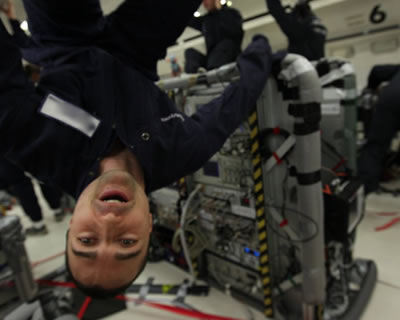Onera is taking part in ICE, a project to verify the principle of equivalence on the microscopic scale, using measurements with a cooled atom accelerometer. The instrument was developed in parabolic flight, a first that earned the partners a publication in the journal Nature Communications.
The purpose of the ICE project is to test the principle of equivalence in the continuity of the Microscope space mission. This principle, on which Einstein’s theory of general relativity is based, is equivalent to the universality of the free fall of bodies formulated by Galileo: “All bodies, feathers like lead, have the same law of fall.” The originality of ICE lies in the fact that the test is done on the microscopic level, directly on atoms (while the Microscope mission tests massive macroscopic objects).
The project, mostly financed by Cnes, has brought together several teams of physicists from Onera, Institut d'Optique Graduate School, and the Paris Observatory. It involves the making of a double cold atom interferometer with two species - potassium and rubidium. This interferometer is supposed to measure any difference in acceleration between two species in free fall, which would constitute a violation of the principle of equivalence.

An Onera physicist upside down in the Airbus Zero-G in parabolic flight
In order to ensure very good measurement sensitivity, the experiments were carried out in micro-gravity, in the Novespace Airbus Zero-G chartered by Cnes. The rubidium atoms to be measured were aggregated in a high vacuum in the form of a cold ball of several millimeters in diameter.
Onera is specifically in charge of the laser part of the project which, in particular, has the objective of cooling the atoms to a temperature of a few micro-Kelvins, revealing their wave properties which are the key to the ultra-accurate measurements sought.




